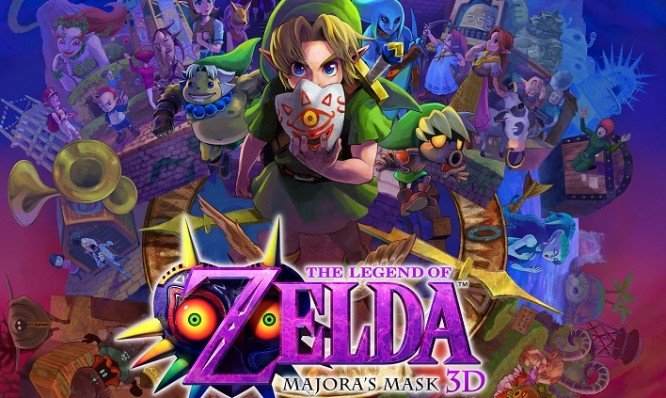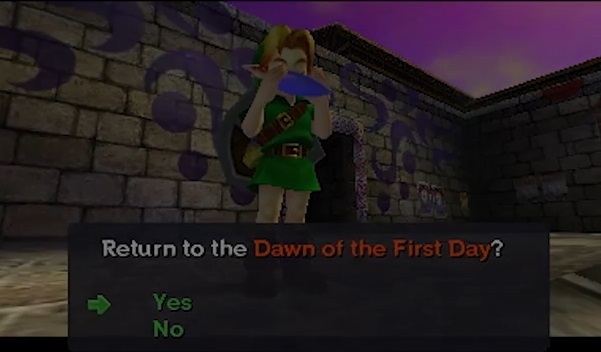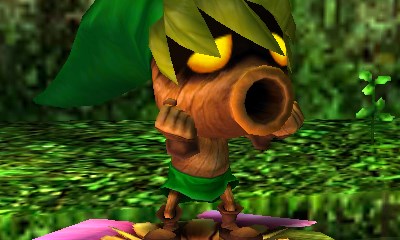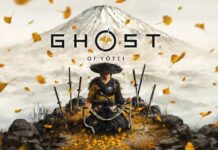 If you’ve read my previous Legend of Zelda series’ reviews like A Link Between Worlds and Wind Waker HD, you may have gauged that my enjoyment of the series is a lot like my fandom for the band AC/DC – There are certain periods of time I didn’t enjoy, so I’ve blocked them out of my memory. With the Zelda games, I sort of dropped out after Ocarina of Time, and didn’t come back until my wife bought Twilight Princess for the Wii. I DID rent (there’s a term you don’t hear much anymore right?) Majora’s Mask, but I didn’t really enjoy it enough to keep renting it to beat the game (I’ll explain why later.) In fact, the most enjoyable thing about Majora’s Mask for me in the 15 years since release was the bizarre “BEN” Urban Legend that eventually spawned forth. I’m not going to link it here since I’d prefer you all slept comfortably tonight.
If you’ve read my previous Legend of Zelda series’ reviews like A Link Between Worlds and Wind Waker HD, you may have gauged that my enjoyment of the series is a lot like my fandom for the band AC/DC – There are certain periods of time I didn’t enjoy, so I’ve blocked them out of my memory. With the Zelda games, I sort of dropped out after Ocarina of Time, and didn’t come back until my wife bought Twilight Princess for the Wii. I DID rent (there’s a term you don’t hear much anymore right?) Majora’s Mask, but I didn’t really enjoy it enough to keep renting it to beat the game (I’ll explain why later.) In fact, the most enjoyable thing about Majora’s Mask for me in the 15 years since release was the bizarre “BEN” Urban Legend that eventually spawned forth. I’m not going to link it here since I’d prefer you all slept comfortably tonight.
Anyway, with the release of the New Nintendo 3DS, Majora’s Mask has been revamped and was part of the major launch. 15 years have passed, and I’ve since swallowed my then-teenage pride that didn’t like the fact that it wasn’t a traditional enough Zelda game for my liking, or that the storyline was so…weird. So, I sat down with an open mind, and re-introduced myself to The Legend of Zelda: Majora’s Mask in its new form. Here’s what I thought.
The Legend of Zelda: Majora’s Mask 3D is developed and published by Nintendo
Release date: February 13th, 2014
Rated: Everyone E+10
Genre: Role Playing
Consoles: Nintendo 3DS (Optimized for New Nintendo 3DS)
While the idea of a rescuing a kidnapped princess isn’t really hearts and flowers to begin with, The Legend of Zelda: Majora’s Mask is an even darker pathway into the series’ universe. The game really spares the lengthy opening sequence, and opens with smaller cutscenes introducing you to the main antagonist Skull Kid, who wears a bizarre looking headpiece, and transforms you into a Deku Scrub after falling into the land of Termina. The rest of the next hour or so is a playable tutorial of sorts which gets you ready for the rest of the game.
Skull Kid, introduced in Ocarina of Time is an adult-fearing child who likes playing tricks on others at the best of times. As it turns out, the mask he’s wearing is the stolen Majora’s Mask, and his given him an unruly sense of evil, so much so that he plans on crashing the moon into Termina in 72 hours, essentially wiping out mankind. That’s where you get started with your adventure, after being coerced by the friendly mask salesman (who doesn’t look so friendly) to help him get Majora’s Mask back. He’ll also help you turn into your regular form again early in the game.
The game takes place in the land of Termina and specifically around the small, but practical clock town. Clock Town is the centerpiece of Termina, providing as the center point for the North, South, East and West regions of the play field. Clock Town contains everything from a bank where you can keep your rupees, to parlour games and even various shops and services.

Your success in-game is really based on your intuitive nature, and of course, your ability to pay attention to the lock. See, the thing is, while you’re told the world will end in 72 hours, it doesn’t necessarily mean you only have 72 in-game hours to do it. That would be cruel, especially with the rate at which time moves in the game. You have to group tasks together, and repeat that same 72 hour cycle over and over again, tending to different ones each time through a self-induced time loop. You can replay the days over and over again until you’ve finally broken through, solved all of the dungeons and various areas of Termina (and tended to the side quests if you’re so inclined) and defeated Skull Kid once and for all.
This need to respect time is one of the reasons the game is a bit smaller than other Zelda titles. The entire 72 hour timeframe is around 1 hour real time, so if you think about it, that doesn’t leave you hours and hours to circle dungeons and solve puzzles. There is a way to extend time, however, which I’ll discuss further below.
While the game is named after Majora and that mask, these headpieces are a major part of the lifeblood of the title. What I really like about the masks is that while they are such a crucial part of the game itself, the quest for them doesn’t ever feel like it dominates the story line. In fact, many are quite easy to obtain, and require little effort at all. There are 24 masks in all, though 3 of them completely change the look and feel of Link’s character altogether. Each mask has specific abilities that you must use to your advantage, and can help you obtain more important items throughout the game. They also come with some consequences for misuse. For example, the Blast Mask can trigger a useful explosion, but costs you half a heart of life. The Deku Mask, that first one you receive allows you to sneak into areas, or hop along the water, but makes you too heavy to swim, meaning you instantly drown if you run out of hops.
Just as important, however, is the Ocarina of Time, and the songs that you can play with them. Bearing in mind the game is played out in a 72 hour cycle, there’s no way that you can do everything you need to do in that amount of time, especially considering you’re playing in a sped up version (rather than in real-time.) The Ocarina will allow you to do things like bend time to your advantage, which you will have to do almost as often as you save. The Song of Time, for example, can be played forward or backward with different effect (one warps you to the beginning of the 72 hour period while the other allows you to skip ahead to solve time based puzzles, giving you more time to be in those dungeons.) Be careful with playing with time though – While skipping ahead obviously brings you closer to the end of the world, going back in time also means you may lose items. Luckily, you have the chance to confirm beforehand, and with a bank in town, you can even deposit your rupees before you lose them.

Save points in the game are achieved through owl statues scattered throughout Termina. Early in the game, you will also meet an owl who teaches you a song that allows you to fast travel to any of the owl statues you’ve previously saved at. While the map isn’t particularly big compared to other Zelda games (there are only 4 major dungeons – one for each major environmental region of Termina, though you could easily be stuck in the them until the moon crashes,) this is an extremely helpful thing to have in your back pocket because Link doesn’t move very fast on foot, and your horse (whom you lose in the opening cinematic) isn’t an option at the start.
Let’s talk about some of the other fundamentals of the game. The reworked graphics are done well. They’re done in a sense that you can tell that they’ve been updated, but not so much so that it changes the way the entire game looks and feels. When I was going through the map earlier, my initial thought was that the graphics could look better, but quite honestly, they didn’t need to be. I didn’t encounter any glitchy scrolling or trouble zooming in or out with the C-Stick either, and that was a big worry of mine coming into the game.
Zelda games are almost an automatic when it comes to quality soundtracks, and Majora’s Mask may actually be one of the best and most appropriate in the series. This game has been concocted in a way to make you feel constantly uncomfortable, and uneasy about your surroundings, and the general feel of the game. The soundtrack captures this perfectly. You’re greeted with dark and foreboding melodies throughout to match the brand and tone of the game and the dungeons. There’s no motivating, cheery overworld themes as you proudly march through killing less than angry blobs and skeletons. Each song is specifically crafted perfectly to fit the mood, which is rarely a happy one.

The new controls and minor additions (like the ease in which you obtain the Bomber’s Notebook this time around) are a great help in this game. While it takes a long time to get used to the C-Stick and the additional camera perspective (the stick can be too sensitive at times, and not sensitive other times) being able to quickly shuffle through your masks and have constant access to the map is a welcome help, and one of the best things about playing RPGs on the Nintendo 3DS in general. About the only thing I had difficulty with (and it can’t be helped) is that my fumbly fingers don’t like the Z-Targeting the way it works. I won’t fault Nintendo for that, however. That’s on me.
With the helpful and quick options in the second screen, it should take you a lot less time to complete Majora’s Mask this time around. The story mode will take experienced Zelda players around 15 hours or so, maybe less if you remember the general gist of a lot of the puzzles. Casual players like me will have around 20-25 hours of gameplay from the story mode, and that’s if you’re sticking to the storyline and not trying to complete everything under the sun.
The Legend of Zelda: Majora’s Mask is a good, solid game from top to bottom. It’s not my favourite in the series, and I guarantee that it never will be, but it’s definitely a better game than I remembered it being back when I played the original. I don’t think it’s for everybody, but the Zelda-style RPG games are so few and far between that if you crave something role-playing that’s a little out of the ordinary, this definitely won’t disappoint you.
Final Ratings
Gameplay: 4.5 / 5
Graphics: 4 / 5
Sound: 5 / 5
Controls: 4.5 / 5
Lasting Appeal/Replayability: 3.5 / 5
Overall Rating: 4.3 / 5 (86%)
The Legend of Zelda: Majora’s Mask 3D is now available for Nintendo 3DS at Best Buy and online at BestBuy.ca



